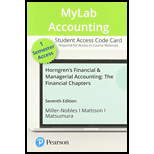
1.
Concept Introduction: Deferred expenses are advance payments for future expenses. When a business prepays an expense, it can debit an asset account and defer the recognition of the expense. Deferring an expense creates an asset, thus, the account is debited to recognize this prepayment.
The adjustment entry for accrued salaries on December 31.
2.
Concept Introduction: Adjusting entries are made at the end of the accounting period to record revenues in the period they are earned and expenses in the period they occur. Assets and liabilities are also updated by
The adjustment entry to record earning of revenue.
3.
Concept Introduction: Adjusting entries are made at the end of the accounting period to record revenues in the period they are earned and expenses in the period they occur. Assets and liabilities are also updated by adjustment entries. To present true and fair financial statements, adjustment entries are also required.
The T accounts for passed entries.
Want to see the full answer?
Check out a sample textbook solution
Chapter 3 Solutions
Pearson eText Horngren's Financial & Managerial Accounting: The Financial Chapters -- Instant Access (Pearson+)
- Quentin sells a parcel of land for $80,000 cash, and the buyer assumes Quentin's liability of $12,000 on the land. Quentin's basis in the land is $65,000. What is the gain or loss he will recognize on the sale? A. $3,000 loss B. $15,000 gain C. $27,000 gain D. $37,000 gainarrow_forwardVelocity Industries used 9,200 machine hours (Driver) on Job #45. Total machine hours are 28,000. Assume Job #45 is the only job sold during the accounting period. If the total overhead applied is $196,000, what is the overhead applied in COGS?arrow_forwardTony sold a building to Carol. The sales price was $420,000. Tony paid a commission to a real estate broker of $22,000 and paid other selling expenses of $5,800. Tony's basis in the building was $285,000. What was Tony's gain realized on the sale of the building?arrow_forward
- Lila Corporation reported net sales of $80,000. The beginning accounts receivable was $15,000, and the ending accounts receivable was $21,000. What is the days sales collected for Lila Corporation? (Rounded answer to nearest day)arrow_forwardEleanor Technology, a firm with no net debt, reports cash flow from operations of $7,840 million in its cash flow statement after adding $2,250 million in accruals to earnings. It reported cash investments in operations of $4,680 million. What were Eleanor Technology's free cash flow and earnings for the period? Help me with thisarrow_forwardKaiser Industries earned an operating income of $35,500 with a contribution margin ratio of 0.40. Actual revenue was $320,000. Calculate the total fixed cost. Round your answer to the nearest dollar, if required.arrow_forward
- Provide correct option accounting questionarrow_forwardA business has revenue of $895,000, cost of goods sold of $356,000, operating expenses of $198,000, and pays $82,000 in taxes, what is the net income?arrow_forwardZeta Corporation began the accounting period with $90,000 of merchandise, and the net cost of purchases was $310,000. A physical inventory showed $110,000 of merchandise unsold at the end of the period. The cost of goods sold by Zeta Corporation for the period is ____.arrow_forward
- I am searching for the accurate solution to this accounting problem with the right approach.arrow_forwardHow does triple bottom line reporting enhance traditional financial statements? (a) It deals exclusively with social impacts (b) It only focuses on environmental costs (c) It measures profit, people, and planet impacts simultaneously (d) It reports financial profits three ways MCQarrow_forwardConsider the overall effects on Peninsula Lawn Care from selling and performing services on account for $9,200 and paying expenses totaling $5,850. What is Peninsula Lawn Care's net income or net loss? A. Net loss of $3,650 B. Net income of $4,650 C. Net income of $7,800 D. Net income of $3,350 helparrow_forward
- Century 21 Accounting Multicolumn JournalAccountingISBN:9781337679503Author:GilbertsonPublisher:Cengage
 Intermediate Accounting: Reporting And AnalysisAccountingISBN:9781337788281Author:James M. Wahlen, Jefferson P. Jones, Donald PagachPublisher:Cengage Learning
Intermediate Accounting: Reporting And AnalysisAccountingISBN:9781337788281Author:James M. Wahlen, Jefferson P. Jones, Donald PagachPublisher:Cengage Learning  Cornerstones of Financial AccountingAccountingISBN:9781337690881Author:Jay Rich, Jeff JonesPublisher:Cengage LearningPrinciples of Accounting Volume 1AccountingISBN:9781947172685Author:OpenStaxPublisher:OpenStax College
Cornerstones of Financial AccountingAccountingISBN:9781337690881Author:Jay Rich, Jeff JonesPublisher:Cengage LearningPrinciples of Accounting Volume 1AccountingISBN:9781947172685Author:OpenStaxPublisher:OpenStax College





